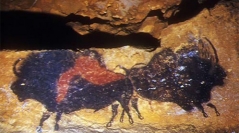

 Comptes Rendus Palevol
5 (1-2) - Pages 203-211
Comptes Rendus Palevol
5 (1-2) - Pages 203-211During the glaciation of the Würm, the rock and movable art of the hunters – gatherers of Cro-Magnon (approximately 35 000 to 8000 years ago) is made of animals, human beings and geometrical signs. The everyday life is given rhythm by the seasons. They are rather often reflected in the morphology and/or the behaviour of the big herbivores represented. The presence of certain sorts indicates cold episodes: mammoths, woolly rhinoceros, ovibos, reindeers, megaceros. Others testify of reheating (as the interstadium of Lascaux): horses, bisons and especially aurochs, deer and hinds, ibexes. At the end the glaciation, the cold fauna is not any more represented. The great big animal art of the Cro-Magnons disappears, being replaced by an outdoor rock art, simplistic and often narrative.
Palaeolithic art, seasonal aspects, climates, cold fauna, temperate fauna, mammoth